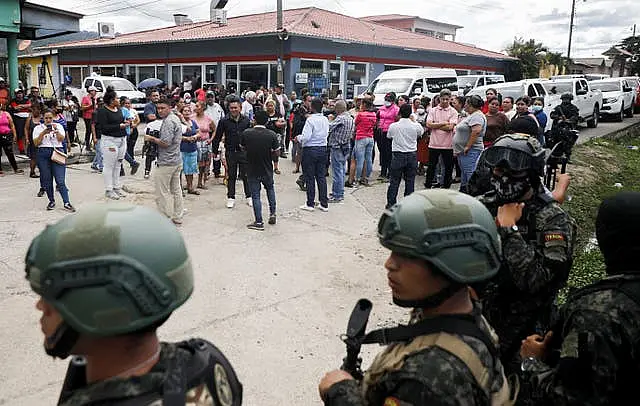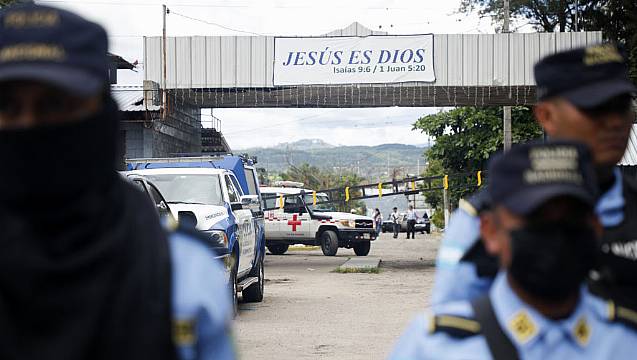Gang members in a women’s prison in Honduras slaughtered 46 other women inmates by spraying them with gunfire, attacking them with machetes and then locking survivors in their cells and dousing them with flammable liquid, an official said.
The carnage in Tuesday’s riot was the worst atrocity at a women’s prison in recent memory, something president Xiomara Castro called “monstrous”.
Relatives said inmates at the facility had been threatened for weeks by members of the notorious Barrio 18 gang.
Chillingly, the gang members were able to arm themselves with prohibited weapons, brush past guards and attack; they even carried locks to shut their victims inside, apparently to burn them to death.

The intensity of the fire left the walls of the cells blackened and beds reduced to twisted heaps of metal.
“A group of armed people went to the cellblock of a rival gang, locked the doors, opened fire on them,” said Juan Lopez Rochez, the chief of operations for the country’s National Police.
Miguel Martinez, a security ministry spokesman, said the attack was taped by security cameras, up to the moment the gang members destroyed them in what he called a “planned” attack.
“You can see the moment in which the women overcome the guards, leaving them helpless, and take their keys,” Mr Martinez said.
Ms Castro said Tuesday’s riot at the prison in the town of Tamara, about 30 miles north-west of Honduras’ capital, was “planned by maras (street gangs) with the knowledge and acquiescence of security authorities”.
Ms Castro fired security minister Ramon Sabillon, and replaced him with Gustavo Sanchez, who had been serving as head of the National Police.
But Ms Castro did not explain how inmates identified as members of the Barrio 18 gang were able to get guns and machetes into the prison, or move freely into an adjoining cell block.
Initial reports suggested the doors to the gang’s cell block had been left open, facilitating the attack.

The amount of weaponry found in the prison after the riot was impressive: 18 pistols, an assault rifle, two machine pistols and two grenades — all of which were smuggled into the prison.
“Obviously, there must have been human failures,” Mr Lopez Rochez said. “We are investigating all the employees at the centre.”
Sandra Rodriguez Vargas, the assistant commissioner for Honduras’ prison system, said the attackers “removed” guards at the facility — none appeared to have been injured — around 8m on Tuesday.
Twenty-six of the victims were burned to death and the remainder shot or stabbed, said Yuri Mora, the spokesman for Honduras’ national police investigation agency. At least seven inmates were being treated at hospital.
The riot’s death toll surpassed that of a fire at a female detention centre in Guatemala in 2017, when girls at a shelter for troubled youths set fire to mattresses to protest against rapes and other mistreatment at the overcrowded institution. The smoke and fire killed 41 girls.
The worst prison disaster in a century also occurred in Honduras, in 2012, at the Comayagua men’s penitentiary, where 361 male inmates died in a fire possibly caused by a match, cigarette or some other open flame.
There were ample warnings ahead of Tuesday’s tragedy, according to Johanna Paola Soriano Euceda, who was waiting outside the morgue in Tegucigalpa for news about her mother, Maribel Euceda, and sister, Karla Soriano. Both were on trial for drug trafficking but were held in the same area as convicted prisoners.

Ms Soriano Euceda said they had told her on Sunday that “they (Barrio 18 members) were out of control, they were fighting with them all the time. That was the last time we talked”.
Officials described the killings as a “terrorist act” but also acknowledged that gangs essentially had ruled some parts of the prison.
Julissa Villanueva, head of the prison system, suggested the riot started because of recent attempts by authorities to crack down on illicit activity inside prison walls and called Tuesday’s violence a reaction to moves “we are taking against organised crime”.
“We will not back down,” Ms Villanueva said in a televised address after the riot.
Gangs wield broad control inside the country’s prisons, where inmates often set their own rules and sell prohibited goods.
“The issue is to prevent people from smuggling in drugs, grenades and firearms,” said Honduran human rights expert Joaquin Mejia. “Today’s events show that they have not been able to do that.”
Meanwhile, the grim task continued of trying to identify the bodies, some terribly burned. Officials on Wednesday began turning over some of the corpses to families for burial.
Dozens of anxious, angry relatives gathered outside the rural prison.
“We are here dying of anguish, of pain… we don’t have any information,” said Salomon Garcia, whose daughter is an inmate at the facility.







